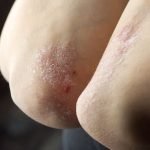The Skin As a Window: How Skin Conditions Provide Clues to Internal Health
Thalia Farshchian, ND
Skin, being our largest organ system, serves as an important alert system for internal imbalances in digestion, hormones, immune function, and inflammatory processes. A conventional approach is often geared toward quieting these valuable symptoms with medications like topical ointments and antibiotics. Using a holistic perspective, we have an opportunity to use the external and superficial environment as a clue about a patient’s internal health.
Common skin conditions in primary care practices affecting patient’s of all ages include eczema, acne, and rosacea.
Eczema
Eczema is a chronic inflammatory condition triggered by a combination of genetic and environmental factors.1 Though steroidal creams alleviate the expression of itchy, red skin, the underlying cause remains unsolved. The eczema itself is surely uncomfortable, but risk of developing asthma and allergic rhinitis is also higher in children with eczema compared to those who are unaffected.2 These conditions together can severely impact a patient’s activities of daily living. By addressing the underlying causes early, these children have an opportunity to mature into healthy adults.
In treating eczema, the complexity of my assessment varies based on the age of my patient. In infants, toddlers, and young children, I have found success simply by focusing on food sensitivities and gut microbiology as inflammatory triggers. Common food allergens include dairy, gluten, corn, soy, nuts, and eggs. I typically do a blood spot food sensitivity panel to guide the 4-week elimination challenge. Identification and elimination of food allergens can alleviate the inflammation causing the eczema. Depending on the number of sensitivities and types of foods the patient is shown to be sensitive to, I will implement a gut healing protocol using a combination of L-glutamine, Ulmus rubra (slippery elm), Althaea officinalis (marshmallow root ), Aloe vera, and zinc carnosine.
Though addressing food sensitivities is an important step toward resolution, gut microflora should also be addressed to improve the immune system and potentially reduce food intolerances. Preventatively, studies have shown children have had a lower incidence of food allergies and eczema when an expectant mother is supplemented with the probiotic strain, Lactobacillus rhamnosus HN001.3 This strain of probiotic is also effective in infants for prevention of eczema and rhinoconjunctivitis.4
In older children and adults, I run comprehensive digestive stool analyses and/or lactulose breath tests to evaluate inflammation triggered by dysbiosis from bacteria, yeast, or parasites.5 The laboratory completes sensitivity testing on cultured organisms, to aid in choosing an appropriate treatment.
Acne and Rosacea
Despite differences in clinical manifestations, acne and rosacea are 2 linked chronic inflammatory conditions sharing the same pathogenesis.6 These conditions are typically addressed by patients, due to their aesthetic concerns about appearance, but from a naturopathic perspective this is an opportunity to support preventative wellness. For example, patients affected by rosacea have a higher likelihood of developing cardiovascular disease, with elevations in total cholesterol, low-density lipoprotein (LDL) particles, and C-reactive protein (CRP).7
The facial pattern for acne can be used to help determine what systems require attention. For example, patients with acne around their mouths, with or without cyclic changes, will likely require more hormonal support. Those affected by acne across the forehead often do best with digestive support. Acne on a patient’s cheeks sheds light on respiratory support.
Small intestinal bacterial overgrowth (SIBO) is more prevalent in those affected by rosacea.8 Similar to eczema, I assess food sensitivities and dysbiosis as inflammatory triggers.
For acne affected by hormone imbalance, low progesterone and high testosterone are both common. In instances of elevated testosterone, I use Serenoa repens (saw palmetto), Pygeum, and Urtica dioica (nettles). For low progesterone, I will use Agnus castus (chasteberry) extract or oral micronized progesterone.
From a naturopathic perspective, an underlying cause of acne and rosacea is the liver’s inability to clear toxins from the body. The adjunctive use of liver-supporting herbs like Arctium lappa (burdock), nettles, Taraxacum officinale (dandelion), and Silybum marianum (milk thistle) enhances detoxification and can improve skin’s clarity.
For both acne and rosacea, it is important to address them both internally and externally. Patients often try to scrub their condition off with harsh and drying products. I prescribe a combination of 5 products for acne: a green tea cleanser, green tea toner, rosemary serum for spot treatment, apricot moisturizer, and weekly clay mask. For rosacea, I prescribe a gentle cooling cleanser, orange blossom toner, serum for hyperpigmentation, weekly cucumber spirulina masque, and a plum peptide moisturizer.
While conditions of the skin are indicative of an imbalance of the internal environment, oftentimes these external conditions are the driving motivation for a person to seek treatment. Though the patient may simply want their external appearance to improve, this is an opportunity for the practitioner to educate and prevent the development of more serious disease processes.
 Thalia Farshchian, ND strives to educate and motivate her clients to become active participants in their own health and wellness. Specializing in women’s health, digestive conditions, hormone conditions, and weight loss, she pieces together the constellation of symptoms to understand the core issue. She completed her degree in naturopathic medicine at the National College of Natural Medicine, and her BA in psychology from the University of California, Santa Barbara.
Thalia Farshchian, ND strives to educate and motivate her clients to become active participants in their own health and wellness. Specializing in women’s health, digestive conditions, hormone conditions, and weight loss, she pieces together the constellation of symptoms to understand the core issue. She completed her degree in naturopathic medicine at the National College of Natural Medicine, and her BA in psychology from the University of California, Santa Barbara.
References
- Mao W, Mao J, Zhang J, et al. Atopic eczema: a disease modulated by gene and environment. Front Biosci (Landmark Ed). 2014;19:707-717.
- Gustafsson D, Sjöberg O, Foucard T. Development of allergies and asthma in infants and young children with atopic dermatitis – a prospective follow-up to 7 years of age. Allergy. 2000;55(3): 240-245.
- Kuitunen M. Probiotics and prebiotics in preventing food allergy and eczema. Curr Opin Allergy Clin Immunol. 2013;13(3):280-286.
- Wickens K, Black P, Stanley TV, et al. A protective effect of Lactobacillus rhamnosus HN001 against eczema in the first 2 years of life persists to age 4 years. Clin Exp Allergy. 2012;42(7):1071-1079.
- Li Q, Wang C, Tang C, et al. Dysbiosis of gut fungal microbiota is associated with mucosal inflammation in Crohn’s Disease. J Clin Gastroenterol. 2013 Nov 29. [Epub ahead of print]
- Fleischer, AB Jr. Inflammation in rosacea and acne: Implications of patient care. J Drugs Dermatol. 2011;10(6):614-620.
- Duman N, Ersoy Evans S, Atakan N. Rosacea and cardiovascular risk factors: a case control study. J Eur Acad Dermatol Venereol. 2013 Aug 2. [Epub ahead of print]
- Weinstock L, Steinhoff M. Rosacea and small intestinal bacterial overgrowth: Prevalence and response to rifaximin. J Am Acad Dermatol. 2013;68(5):875-876.









